turn signal FORD ESCORT 2001 6.G Owners Manual
[x] Cancel search | Manufacturer: FORD, Model Year: 2001, Model line: ESCORT, Model: FORD ESCORT 2001 6.GPages: 216, PDF Size: 1.78 MB
Page 6 of 216
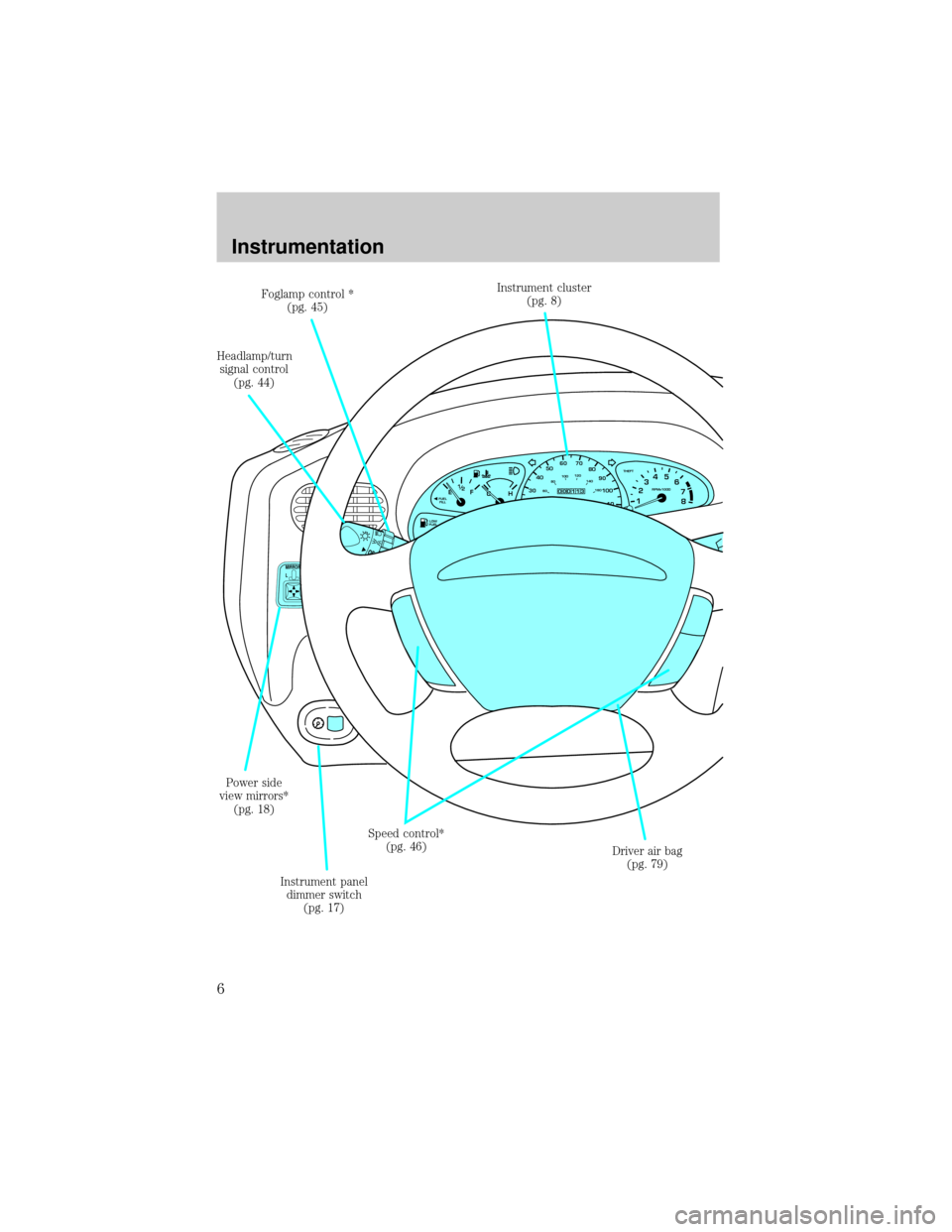
THEFT
LOW
FUEL5060 70
FUEL
FILLEF
CH1
2 /RPMx10001234
5
6
7
8304080
90
1006080100120
140
160000113
MIRROR
L
Headlamp/turn
signal control
(pg. 44)
Power side
view mirrors*
(pg. 18)Instrument cluster
(pg. 8) Foglamp control *
(pg. 45)
Driver air bag
(pg. 79) Speed control*
(pg. 46)
Instrument panel
dimmer switch
(pg. 17)
Instrumentation
6
Page 11 of 216
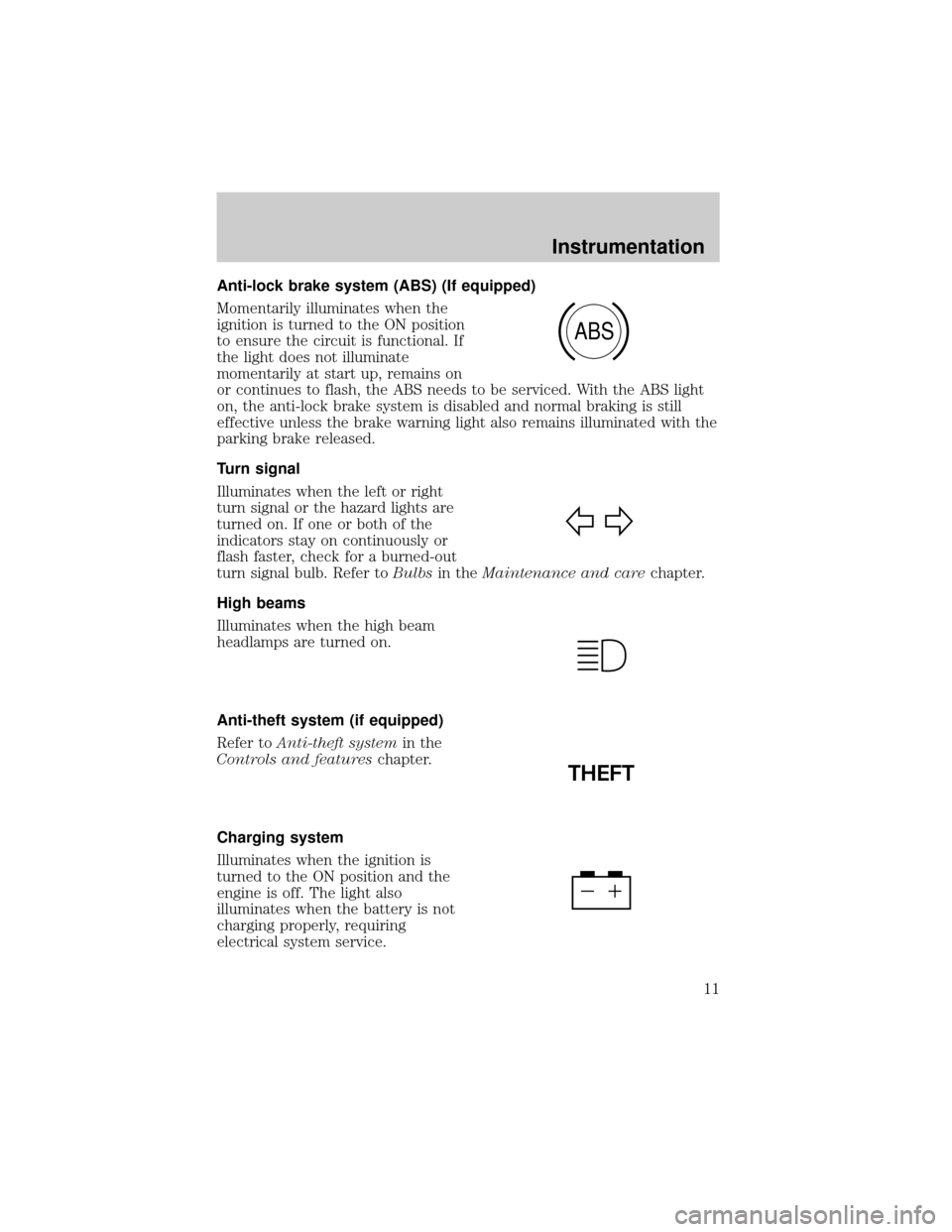
Anti-lock brake system (ABS) (If equipped)
Momentarily illuminates when the
ignition is turned to the ON position
to ensure the circuit is functional. If
the light does not illuminate
momentarily at start up, remains on
or continues to flash, the ABS needs to be serviced. With the ABS light
on, the anti-lock brake system is disabled and normal braking is still
effective unless the brake warning light also remains illuminated with the
parking brake released.
Turn signal
Illuminates when the left or right
turn signal or the hazard lights are
turned on. If one or both of the
indicators stay on continuously or
flash faster, check for a burned-out
turn signal bulb. Refer toBulbsin theMaintenance and carechapter.
High beams
Illuminates when the high beam
headlamps are turned on.
Anti-theft system (if equipped)
Refer toAnti-theft systemin the
Controls and featureschapter.
Charging system
Illuminates when the ignition is
turned to the ON position and the
engine is off. The light also
illuminates when the battery is not
charging properly, requiring
electrical system service.
ABS
THEFT
Instrumentation
11
Page 37 of 216
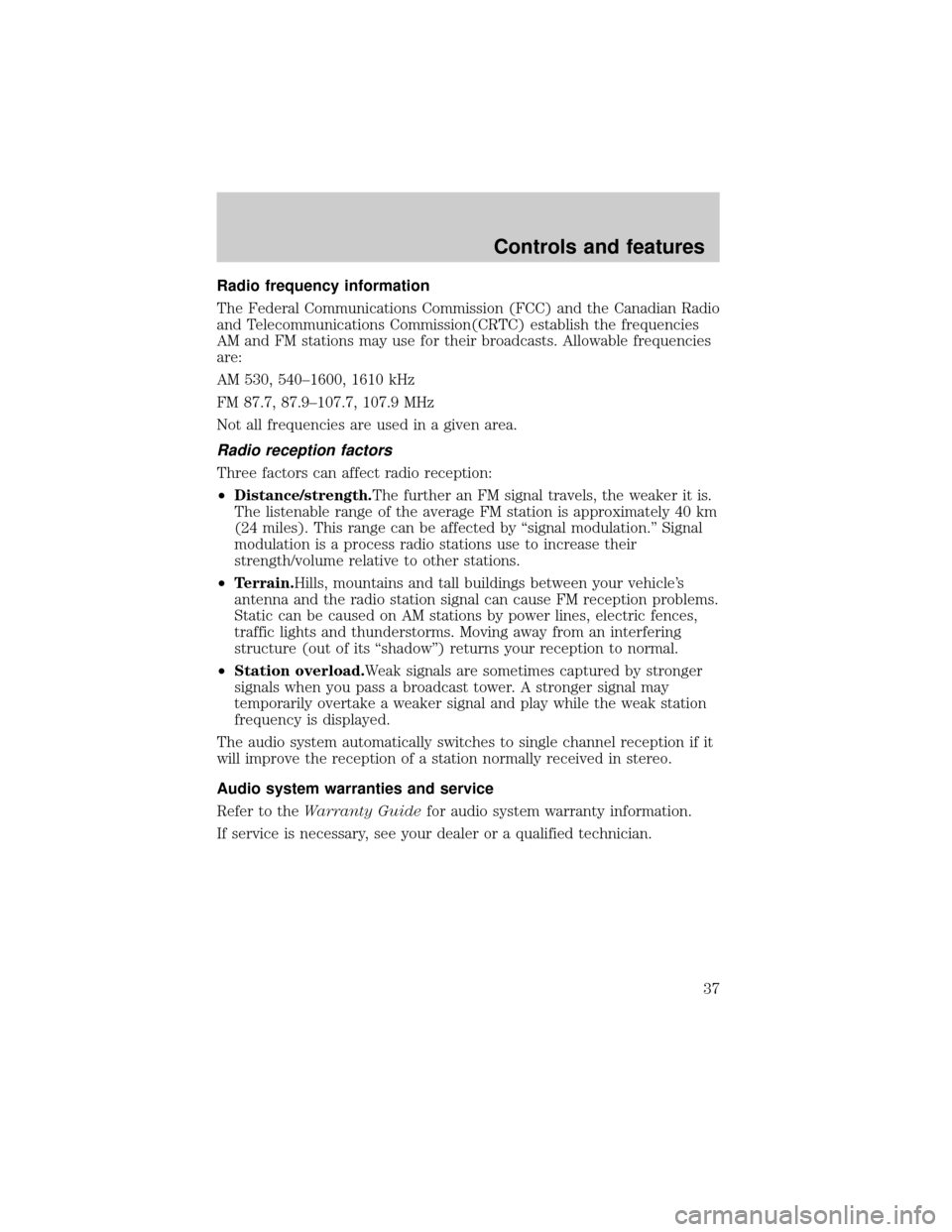
Radio frequency information
The Federal Communications Commission (FCC) and the Canadian Radio
and Telecommunications Commission(CRTC) establish the frequencies
AM and FM stations may use for their broadcasts. Allowable frequencies
are:
AM 530, 540±1600, 1610 kHz
FM 87.7, 87.9±107.7, 107.9 MHz
Not all frequencies are used in a given area.
Radio reception factors
Three factors can affect radio reception:
²Distance/strength.The further an FM signal travels, the weaker it is.
The listenable range of the average FM station is approximately 40 km
(24 miles). This range can be affected by ªsignal modulation.º Signal
modulation is a process radio stations use to increase their
strength/volume relative to other stations.
²Terrain.Hills, mountains and tall buildings between your vehicle's
antenna and the radio station signal can cause FM reception problems.
Static can be caused on AM stations by power lines, electric fences,
traffic lights and thunderstorms. Moving away from an interfering
structure (out of its ªshadowº) returns your reception to normal.
²Station overload.Weak signals are sometimes captured by stronger
signals when you pass a broadcast tower. A stronger signal may
temporarily overtake a weaker signal and play while the weak station
frequency is displayed.
The audio system automatically switches to single channel reception if it
will improve the reception of a station normally received in stereo.
Audio system warranties and service
Refer to theWarranty Guidefor audio system warranty information.
If service is necessary, see your dealer or a qualified technician.
Controls and features
37
Page 46 of 216
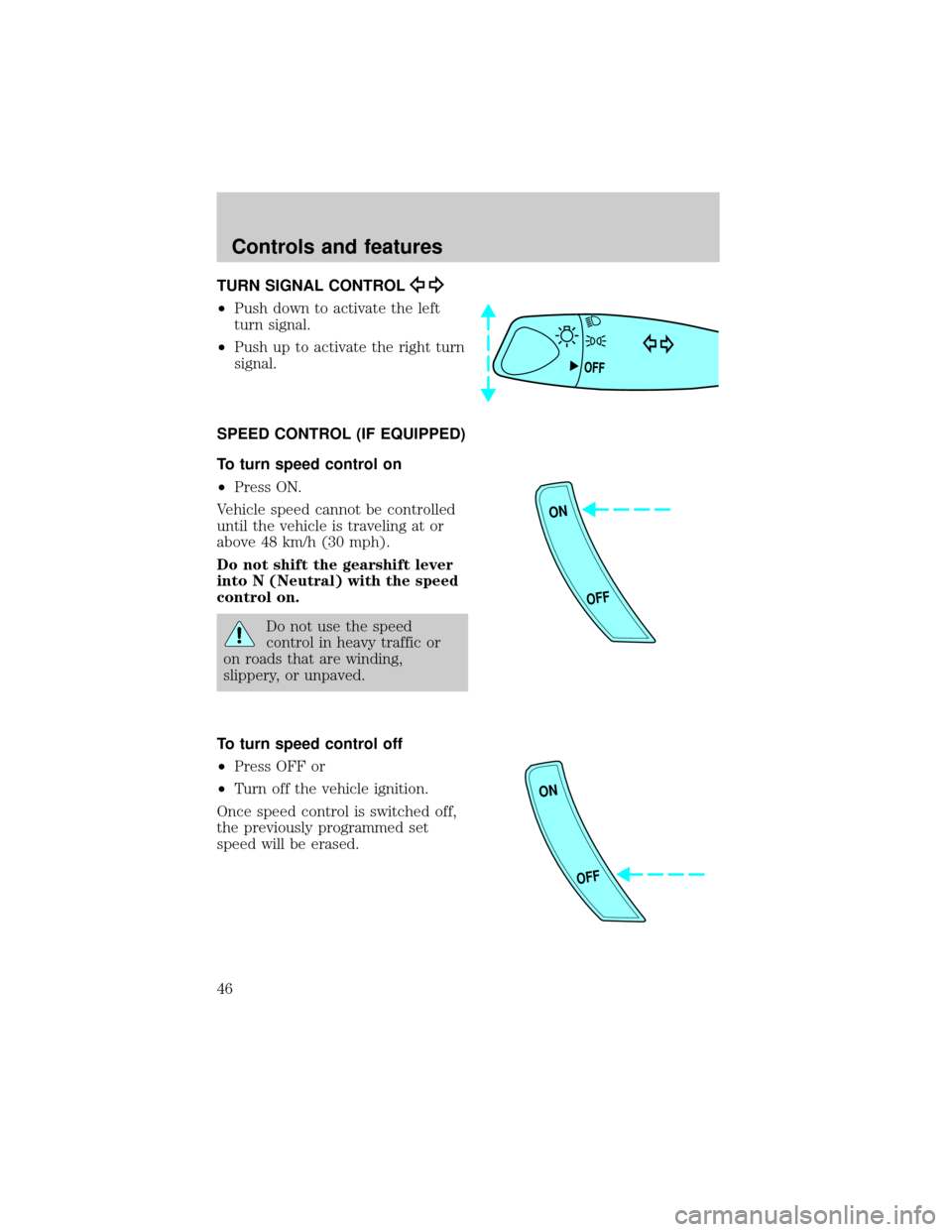
TURN SIGNAL CONTROL
²Push down to activate the left
turn signal.
²Push up to activate the right turn
signal.
SPEED CONTROL (IF EQUIPPED)
To turn speed control on
²Press ON.
Vehicle speed cannot be controlled
until the vehicle is traveling at or
above 48 km/h (30 mph).
Do not shift the gearshift lever
into N (Neutral) with the speed
control on.
Do not use the speed
control in heavy traffic or
on roads that are winding,
slippery, or unpaved.
To turn speed control off
²Press OFF or
²Turn off the vehicle ignition.
Once speed control is switched off,
the previously programmed set
speed will be erased.
OFF
ON
OFF
ON
OFF
Controls and features
46
Page 119 of 216
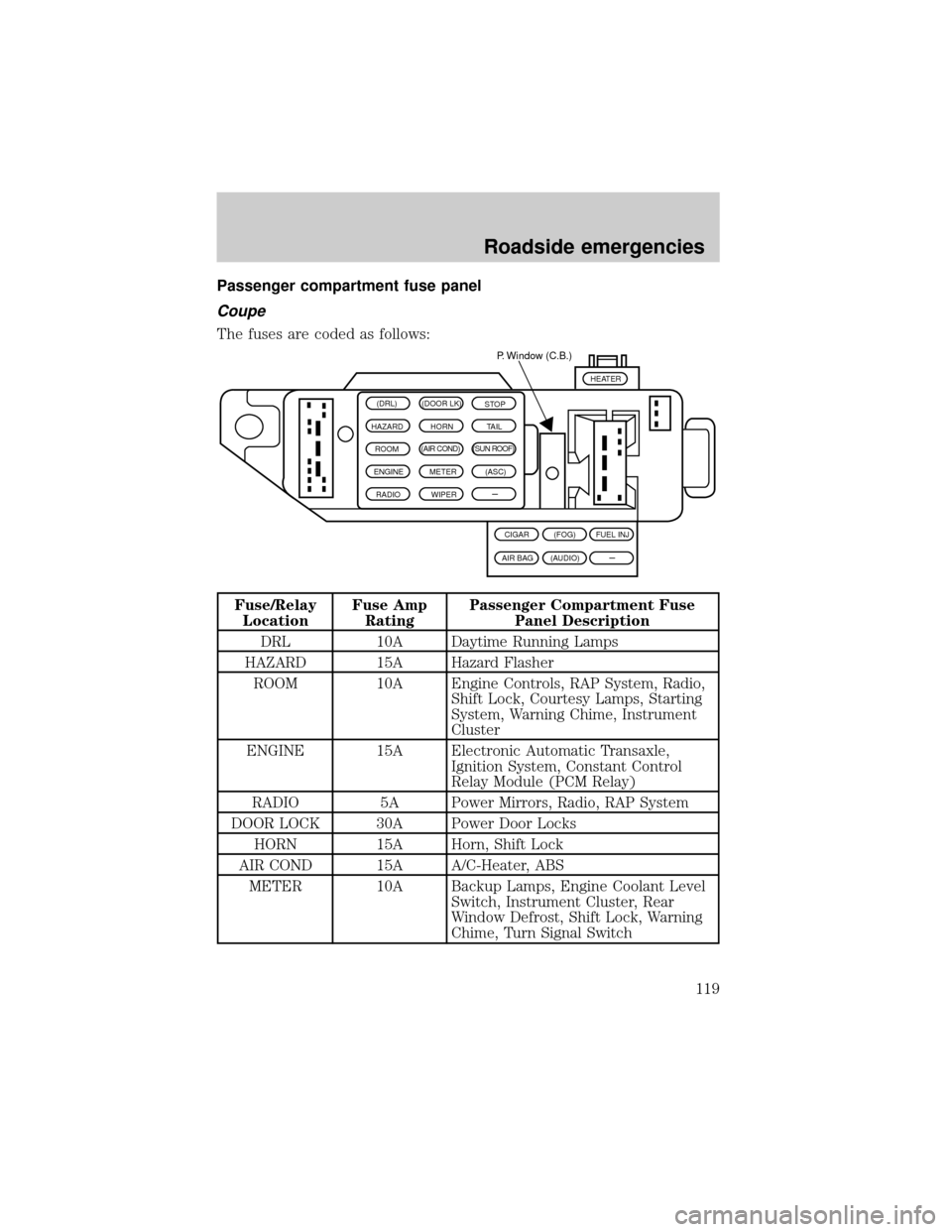
Passenger compartment fuse panel
Coupe
The fuses are coded as follows:
Fuse/Relay
LocationFuse Amp
RatingPassenger Compartment Fuse
Panel Description
DRL 10A Daytime Running Lamps
HAZARD 15A Hazard Flasher
ROOM 10A Engine Controls, RAP System, Radio,
Shift Lock, Courtesy Lamps, Starting
System, Warning Chime, Instrument
Cluster
ENGINE 15A Electronic Automatic Transaxle,
Ignition System, Constant Control
Relay Module (PCM Relay)
RADIO 5A Power Mirrors, Radio, RAP System
DOOR LOCK 30A Power Door Locks
HORN 15A Horn, Shift Lock
AIR COND 15A A/C-Heater, ABS
METER 10A Backup Lamps, Engine Coolant Level
Switch, Instrument Cluster, Rear
Window Defrost, Shift Lock, Warning
Chime, Turn Signal Switch
(DRL) (DOOR LK)
STOP
HAZARD HORN
TAIL
ROOM(AIR COND) (SUN ROOF)
ENGINE METER(ASC)
RADIO
WIPER
–P. Window (C.B.)
(FOG) CIGAR
(AUDIO)
AIR BAGFUEL INJ
HEATER
–
Roadside emergencies
119
Page 121 of 216
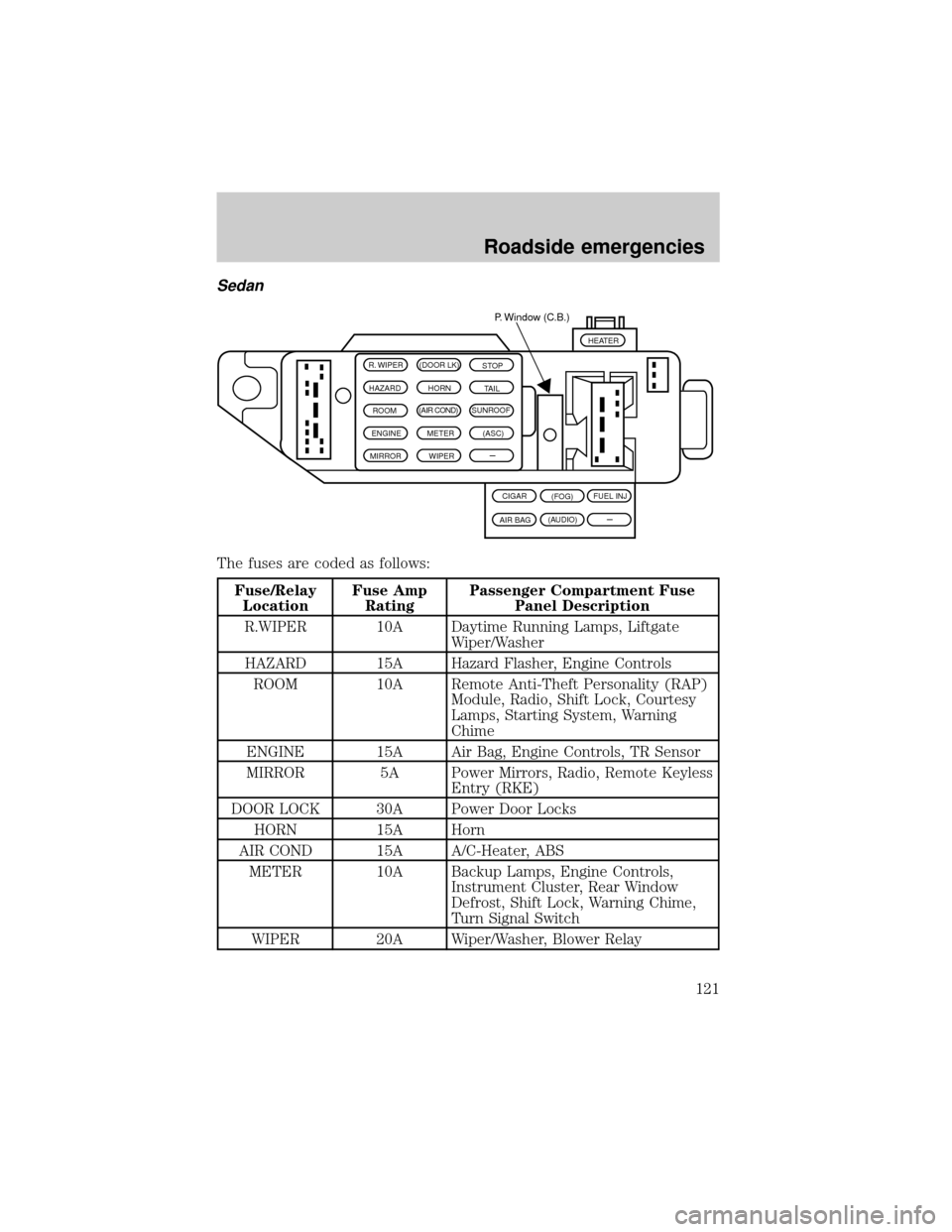
Sedan
The fuses are coded as follows:
Fuse/Relay
LocationFuse Amp
RatingPassenger Compartment Fuse
Panel Description
R.WIPER 10A Daytime Running Lamps, Liftgate
Wiper/Washer
HAZARD 15A Hazard Flasher, Engine Controls
ROOM 10A Remote Anti-Theft Personality (RAP)
Module, Radio, Shift Lock, Courtesy
Lamps, Starting System, Warning
Chime
ENGINE 15A Air Bag, Engine Controls, TR Sensor
MIRROR 5A Power Mirrors, Radio, Remote Keyless
Entry (RKE)
DOOR LOCK 30A Power Door Locks
HORN 15A Horn
AIR COND 15A A/C-Heater, ABS
METER 10A Backup Lamps, Engine Controls,
Instrument Cluster, Rear Window
Defrost, Shift Lock, Warning Chime,
Turn Signal Switch
WIPER 20A Wiper/Washer, Blower Relay
R. WIPER (DOOR LK)
STOP
HAZARD HORN
TAIL
ROOM(AIR COND)SUNROOF
ENGINE METER(ASC)
MIRROR
WIPER
–P. Window (C.B.)
(FOG) CIGAR
(AUDIO)
AIR BAGFUEL INJ
HEATER
–
Roadside emergencies
121
Page 176 of 216
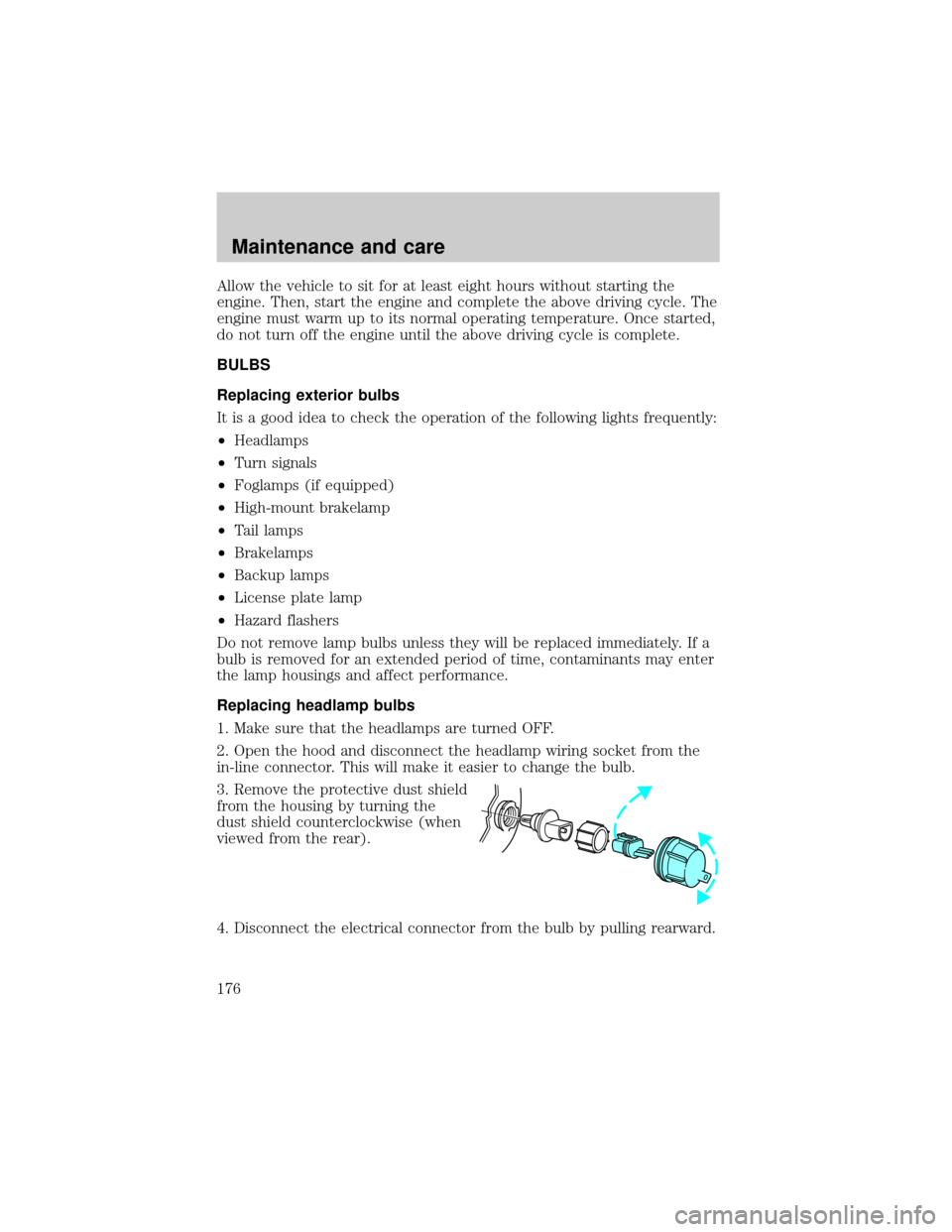
Allow the vehicle to sit for at least eight hours without starting the
engine. Then, start the engine and complete the above driving cycle. The
engine must warm up to its normal operating temperature. Once started,
do not turn off the engine until the above driving cycle is complete.
BULBS
Replacing exterior bulbs
It is a good idea to check the operation of the following lights frequently:
²Headlamps
²Turn signals
²Foglamps (if equipped)
²High-mount brakelamp
²Tail lamps
²Brakelamps
²Backup lamps
²License plate lamp
²Hazard flashers
Do not remove lamp bulbs unless they will be replaced immediately. If a
bulb is removed for an extended period of time, contaminants may enter
the lamp housings and affect performance.
Replacing headlamp bulbs
1. Make sure that the headlamps are turned OFF.
2. Open the hood and disconnect the headlamp wiring socket from the
in-line connector. This will make it easier to change the bulb.
3. Remove the protective dust shield
from the housing by turning the
dust shield counterclockwise (when
viewed from the rear).
4. Disconnect the electrical connector from the bulb by pulling rearward.
Maintenance and care
176
Page 179 of 216
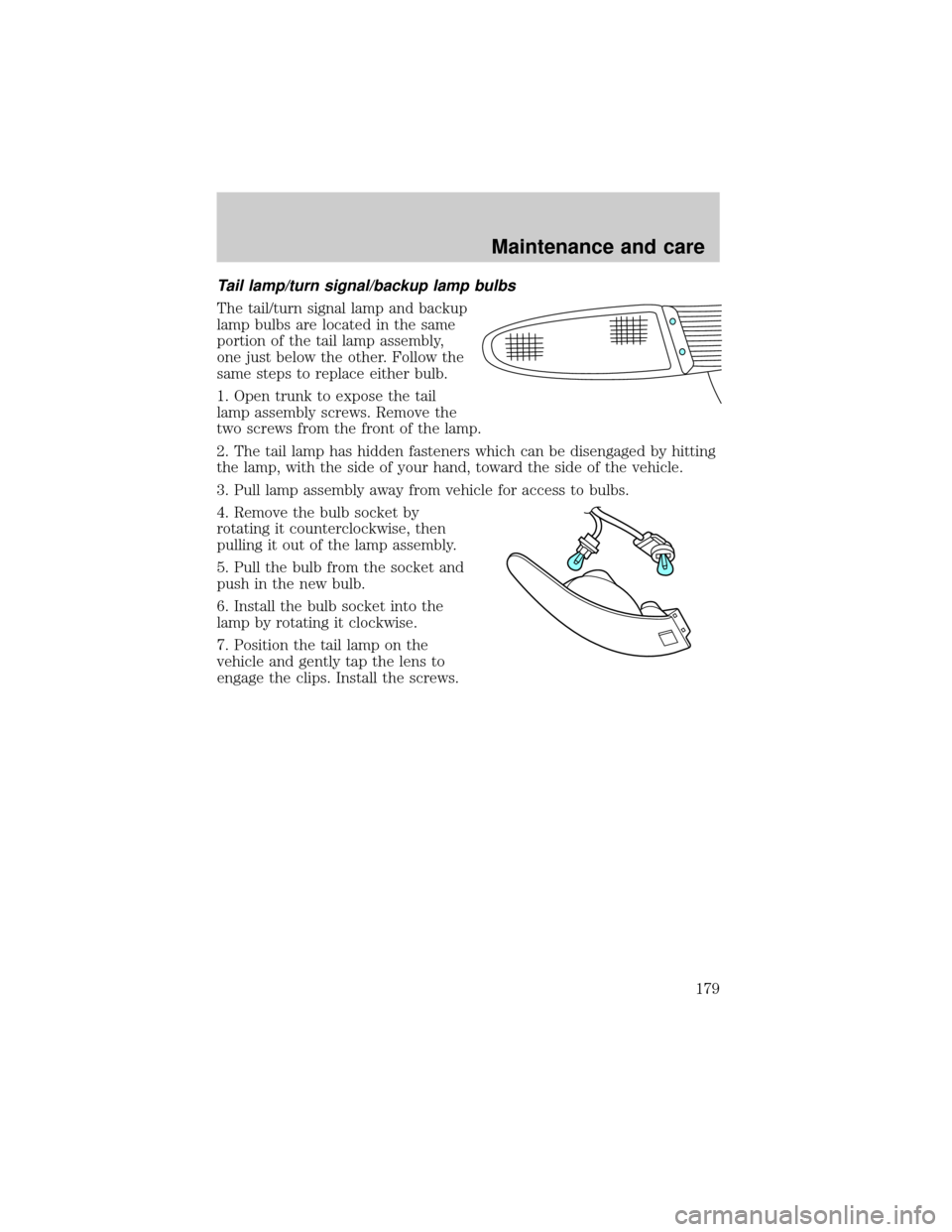
Tail lamp/turn signal/backup lamp bulbs
The tail/turn signal lamp and backup
lamp bulbs are located in the same
portion of the tail lamp assembly,
one just below the other. Follow the
same steps to replace either bulb.
1. Open trunk to expose the tail
lamp assembly screws. Remove the
two screws from the front of the lamp.
2. The tail lamp has hidden fasteners which can be disengaged by hitting
the lamp, with the side of your hand, toward the side of the vehicle.
3. Pull lamp assembly away from vehicle for access to bulbs.
4. Remove the bulb socket by
rotating it counterclockwise, then
pulling it out of the lamp assembly.
5. Pull the bulb from the socket and
push in the new bulb.
6. Install the bulb socket into the
lamp by rotating it clockwise.
7. Position the tail lamp on the
vehicle and gently tap the lens to
engage the clips. Install the screws.
Maintenance and care
179
Page 212 of 216

Inspection/maintenance (I/M)
testing ........................................175
Instrument panel ..........................8
cleaning ...................................187
cluster ..................................8, 187
lighting up panel and
interior .......................................17
location of components ..............8
J
Jack ............................................125
positioning ...............................125
storage .....................................125
Jump-starting your vehicle ......129
K
Keys
key in ignition chime ...............13
positions of the ignition ...........44
L
Lamps
bulb replacement
specifications chart ................181
cargo lamps ...............................17
daytime running light ...............44
fog lamps ...................................45
headlamps .........................44, 176
headlamps, flash to pass ..........45
instrument panel, dimming .....17
interior lamps ...................53, 180
replacing bulbs .......176, 178±180
Lane change indicator (see
Turn signal) .................................46
Lights, warning and indicator ......8
air bag ........................................10
anti-lock brakes (ABS) ......11, 99anti-theft ...................................11
brake ..........................................10
charging system ........................11
fuel cap light .............................12
high beam .................................11
low fuel ........................................8
oil pressure ...............................12
safety belt .................................10
service engine soon ....................9
turn signal indicator .................11
Load limits .................................109
GAWR ......................................109
GVWR ......................................109
trailer towing ..........................109
Locks
childproof ..................................54
Lubricant specifications ...191±192
M
Manual transaxle
fluid capacities ........................190
lubricant specifications ..........192
reverse .....................................108
Mirrors
cleaning ...................................185
side view mirrors (power) .......18
Moon roof ....................................52
Motorcraft parts ................171, 189
O
Octane rating ............................169
Odometer .....................................15
Oil (see Engine oil) ..................142
Index
212
Page 214 of 216

Towing .......................................111
trailer towing ..........................111
wrecker ....................................134
Transaxle
automatic operation ...............101
fluid, refill capacities ..............190
lubricant specifications ..........192
Transmission
fluid, checking and adding
(automatic) .............................154
fluid, checking and adding
(manual) .................................156
lubricant specifications ..........191
Trip odometer .............................16
Trunk ...........................................56
remote release ....................18, 59
Turn signal ............................11, 46
V
Vehicle dimensions ...................193
Vehicle Identification Number
(VIN) ..........................................195Vehicle loading ..........................109
Ventilating your vehicle .............97
W
Warning chimes .....................12±13
Warning lights (see Lights) .........8
Washer fluid ..............................147
Water, Driving through .............113
Windows
power .........................................55
Windshield washer fluid and
wipers
checking and adding fluid .....147
checking and cleaning ............160
operation ...................................51
replacing wiper blades ...........161
Wrecker towing .........................134
Index
214